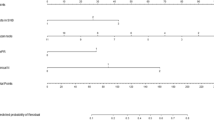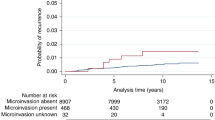Abstract
Although the presence of axillary node metastases in breast cancer is a key prognostic indicator and may influence treatment decisions, a significant proportion of patients diagnosed as axillary node negative (ANN) using standard histopathological techniques may have occult nodal metastases (OMs). A combination of limited step-sectioning (4 x 100 microns intervals) and immunohistochemical staining (with cytokeratin (MNF.116) and MUC1 (BC2) antibodies) was used to detect OM in a retrospective series of 208 ANN patients. OMs were found in 53 patients (25%), and both step-sectioning and immunohistochemical detection significantly improved detection (P < 0.05). Detection using BC2 (25%) was superior to MNF.116 (18%) and haematoxylin and eosin (H&E) (8%). OMs were found in 51 patients using only the first and deepest sectioning levels and BC2 staining. OMs were more frequently found in lobular (38%) than ductal carcinoma (25%), and more frequently in women less than 50 years (41%) than in older women (19%). Univariate overall and disease-free survival analyses showed that the presence, size and number of OM had prognostic significance as did tumour size (disease-free only) and histological and nuclear grade (P > 0.05). Cox multivariate proportional hazard regression analyses showed that the presence and increasing size of OMs were significantly associated with poorer disease-free survival, independently of other prognostic factors (P < 0.05). However there was not a significant independent association of the presence of occult metastases with overall survival (P = 0.11). These findings have important implications with regard to selection of ANN patients for adjuvant therapy.
This is a preview of subscription content, access via your institution
Access options
Subscribe to this journal
Receive 24 print issues and online access
$259.00 per year
only $10.79 per issue
Buy this article
- Purchase on Springer Link
- Instant access to full article PDF
Prices may be subject to local taxes which are calculated during checkout
Similar content being viewed by others
Author information
Authors and Affiliations
Rights and permissions
About this article
Cite this article
McGuckin, M., Cummings, M., Walsh, M. et al. Occult axillary node metastases in breast cancer: their detection and prognostic significance. Br J Cancer 73, 88–95 (1996). https://doi.org/10.1038/bjc.1996.16
Issue Date:
DOI: https://doi.org/10.1038/bjc.1996.16
This article is cited by
-
Prognostic significance of occult lymph node metastases in breast cancer: a meta-analysis
BMC Cancer (2021)
-
Oncologic impact of micrometastases or isolated tumor cells in sentinel lymph nodes of patients with endometrial cancer: a meta-analysis
Clinical and Translational Oncology (2020)
-
Lymph node micrometastasis in gallbladder cancer
Indian Journal of Gastroenterology (2017)
-
Clinical research of intraperitoneal implantation of sustained-release 5-fluorouracil in advanced colorectal cancer
World Journal of Surgical Oncology (2015)
-
Preliminary investigation of intraperitoneal raltitrexed in patients with gastric cancer
World Journal of Surgical Oncology (2014)



